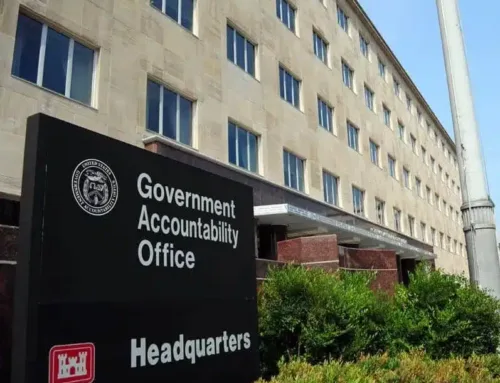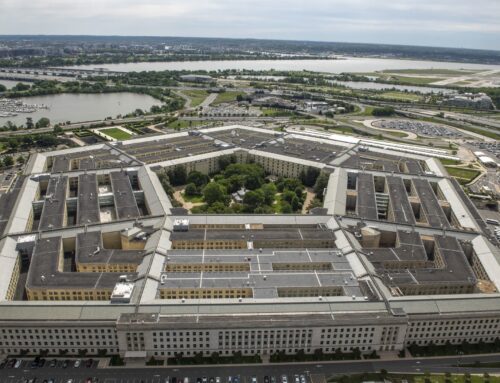Taxpayers for Common Sense wrote a letter to the House & Senate Armed Services Committee urging them to opposed NDAA provisions restricting the Department of Defense’s ability to protect Taxpayers from climate-related supply chain risks. Download or read the letter below.
Dear NDAA Conferee,
Taxpayers for Common Sense is opposed to the recent attacks on the Department of Defense’s efforts to manage climate risks in the House and Senate National Defense Authorization Acts (NDAAs). We believe that the proposed rule by the Federal Acquisition Regulation (FAR) Council, which aims to help DOD and other federal agencies manage climate change risks, is essential for mission delivery and taxpayer protection.
The FAR Council’s proposal requires the largest 1.2% of suppliers to disclose Scope 1 and 2 greenhouse gas (GHG) emissions, and the largest 0.3% of suppliers to disclose Scope 3 GHG emissions, climate risk assessments, and science-based emissions reduction targets. This proposal received favorable responses from various stakeholders, including private sector commenters.[1]
The proposed rule would only affect the largest of the largest suppliers. Furthermore, the information that would be provided is already collected by many of these companies and represents virtually no additional burden. Conversely, stopping or undermining this rule would undermine national security. Limiting DOD’s ability to require major contractors to disclose supply chain risks from adverse weather and natural disaster would impair DOD’s ability to manage and mitigate those risks, which by extension increases risks for men and women in uniform.
Unfortunately, the House and Senate NDAAs contain provisions that would hinder the FAR Council’s rulemaking efforts. The House NDAA’s Section 1822 prohibits the use of funds for requiring contractors to disclose GHG emissions, GHG-related financial risk, or emission reduction targets. Similarly, the Senate NDAA’s Section 820, added during the Committee mark-up of the legislation, targets the FAR Council’s proposed rule by limiting the Secretary of Defense’s ability to require nontraditional defense contractors (NDCs) to provide greenhouse gas inventories or other reports on greenhouse gas emissions.
These provisions undermine the DOD’s goal of assessing and managing its climate risk, which is critical to protecting national security and taxpayers. Exempting contractors from climate disclosure obligations simply because they deliver commercial products and services rather than weapon systems achieves no legitimate purpose. The supply chain risks remain whether they are disclosed or not.
An NDC is defined as an entity that is not currently performing and has not performed any contract or subcontract for the DoD that is subject to full coverage under the cost accounting standards for at least one-year period preceding the solicitation of sources by the DoD.[2] This definition implies that a company, regardless of its size, could potentially qualify as a nontraditional defense contractor if it meets these criteria.
Moreover, the Department of Defense has shown interest in working with nontraditional providers, including large commercial companies, to access unique products and alternative approaches to design, production, and sustainment.[3] Large industrial companies like General Motors, which are re-entering the military market after a long absence, may also be considered nontraditional suppliers.[4]
Climate change poses significant threats and challenges to national security in the coming decades. One example is the strategic interest in the Arctic, where diminishing sea ice coverage has turned the region into a new theater for “great power competition”.[5] Rising sea levels, catastrophic storms, and other climate-related effects threaten both military and civilian infrastructure and can influence migration patterns.[6] Climate change is also considered a “threat multiplier” that aggravates stressors like poverty, environmental degradation, political instability, and social tensions, which can enable terrorist activity and other forms of violence.[7]
The DOD and other federal agencies have been working to increase resilience to the effects of climate change on infrastructure and adapt to changing national security requirements. However, the growing need for military capabilities to respond to disasters and the effort to restructure the force for great-power competition may create conflicting demands.[8] To address these challenges, it is crucial to integrate climate change consequences into national security and defense strategies and develop a comprehensive approach that includes reducing emissions, building climate resilience, and crafting an Arctic strategy that acknowledges climate change as the key to the region’s future.
All of this adds to the costs borne by taxpayers. In our report “Paying the Price of Climate Change: Taxpayers Footing the Bill for Increasing Costs of Climate Change,” TCS highlights the significant financial burden that climate change imposes on taxpayers. For example, taxpayers spent more than $120 billion responding to disasters in 2017 alone.[9] To put this into perspective, a federal agency funded at an amount equal to the 2017 disaster spending would have received more funding than the combined fiscal year appropriations for the Departments of Commerce, Energy, Interior, Labor, Transportation, Treasury, as well as the Environmental Protection Agency and the U.S. Army Corps Engineers.
We have also emphasized the importance of transparency and accountability in managing climate risks. By implementing the FAR Council’s proposal, the Department of Defense and other federal agencies can make more informed decisions about their supply chains and better protect taxpayers from the escalating costs of climate change.
We urge the NDAA conferees to reject the idea that the federal government must remain blind to the significant risks posed by climate change to mission delivery and taxpayer protection. We urge you to strike Sec. 1822 of the House NDAA and Sec. 820 of the Senate NDAA in order to allow the Secretary of Defense to require defense contract recipients to submit greenhouse gas emissions inventories, climate risk assessments, or science-based emissions reduction targets if such submissions are deemed important for protecting supply chain resilience or achieving taxpayer savings.
In case the conferees are unsuccessful in defending DOD’s efforts to protect national security from climate risk, we urge you to add language to Sec. 820 of the Senate NDAA that would extend the deadline for small businesses to submit Scope 1 and 2 GHG emissions inventories from one year to two years, while removing the exemption for non-traditional defense contractors. This extension would be more logical if applied to small businesses rather than non-traditional defense contractors, which are among the nation’s largest companies and can easily afford to prepare GHG emissions inventories within a one-year timeframe.
We appreciate your attention to this critical issue and hope that you will consider our recommendations to ensure that the federal government effectively addresses climate risks and protects taxpayers. If you have any questions, please contact me or Gabe Murphy at gabe@taxpayer.net.
Sincerely,
Stephen Ellis
President
[1] Federal Acquisition Regulation: Disclosure of Greenhouse Gas Emissions and Climate-Related Financial Risk, 87 Fed. Reg. 24569 (November 14, 2022) (to be codified at 48 C.F.R. pt. 1, 2, 4, 12, 15, 23, 42, 52).
[2] Redstone Government Consulting. “DoD Attempts to Open the Door to More Nontraditional Contractors.” Redstone GCI Blog, January 29, 2020. https://info.redstonegci.com/blog/dod-attempts-to-open-the-door-to-more-nontraditional-contractors.
[3] Grant, August. “Non-Traditional Defense Companies Can Provide the Military with Unique Capabilities.” RealClearDefense, March 28, 2020. https://www.realcleardefense.com/articles/2020/03/28/non-traditional_defense_companies_can_provide_the_military_with_unique_capabilities_115155.html.
[4] Thompson, Loren. “How Top Military Contractors Raytheon and BAE Systems Are Drawing Non-Traditional Suppliers into Defense.” Forbes, January 24, 2020. https://www.forbes.com/sites/lorenthompson/2020/01/24/how-top-military-contractors-raytheon-and-bae-systems-are-drawing-non-traditional-suppliers-into-defense/?sh=24ac94846af2.
[5] Taxpayers for Common Sense, “Paying the Price of Climate Change,” June 7, 2023, https://www.taxpayer.net/climate/paying-the-price/ .
[6] U.S. Government Accountability Office. 2022. “National Security Snapshot: Climate Change Risks to National Security.” GAO-22-105830. Washington, DC: U.S. Government Accountability Office. https://www.gao.gov/assets/gao-22-105830.pdf
[7] American Security Project, “National Defense Strategy: Climate Change in the Age of Great Power Competition,” accessed October 4, 2023, https://www.americansecurityproject.org/climate-change-in-the-age-of-great-power-competition/.
[8] Atlantic Council, “Reality Check #13: Great-power competition threatens climate disaster response,” accessed October 4, 2023, https://www.atlanticcouncil.org/content-series/reality-check/reality-check-13-great-power-competition-threatens-climate-disaster-response/.
[9] Taxpayers for Common Sense, “Paying the Price of Climate Change,” June 7, 2023.











Get Social